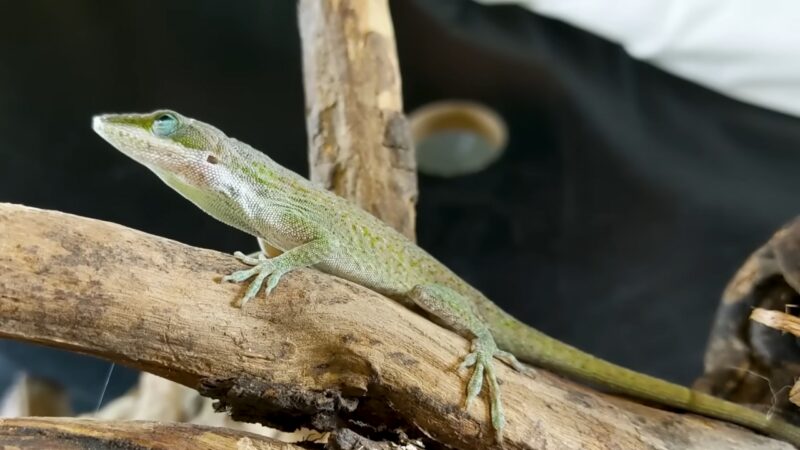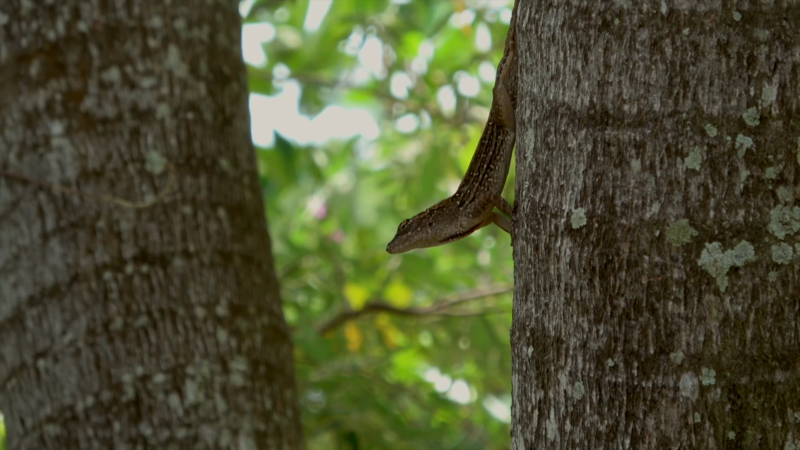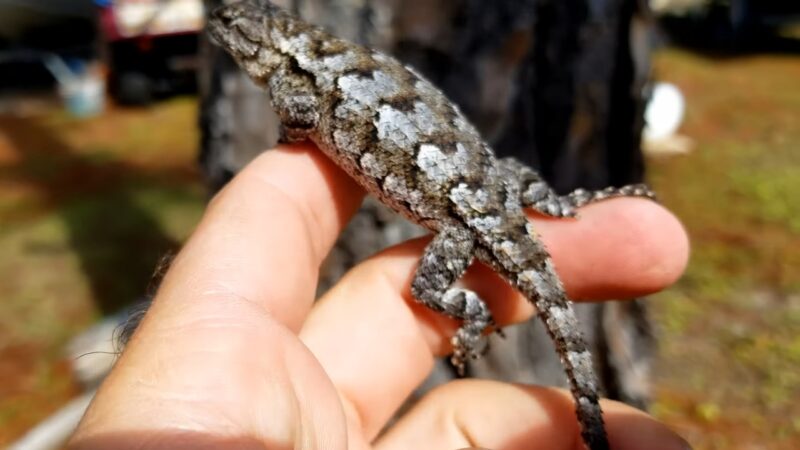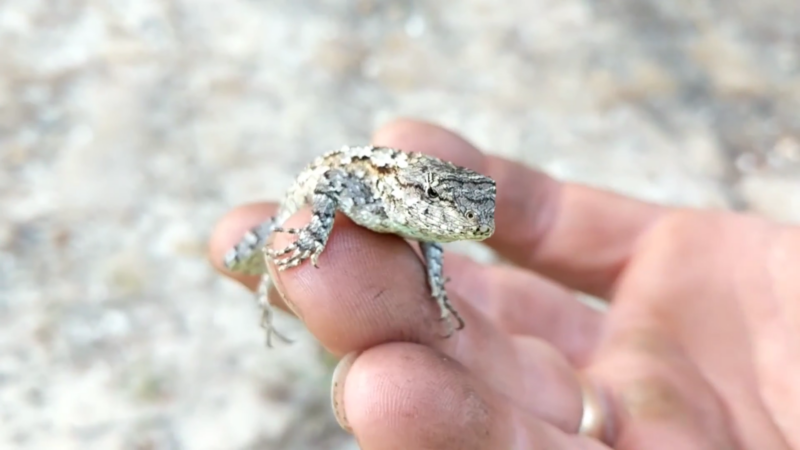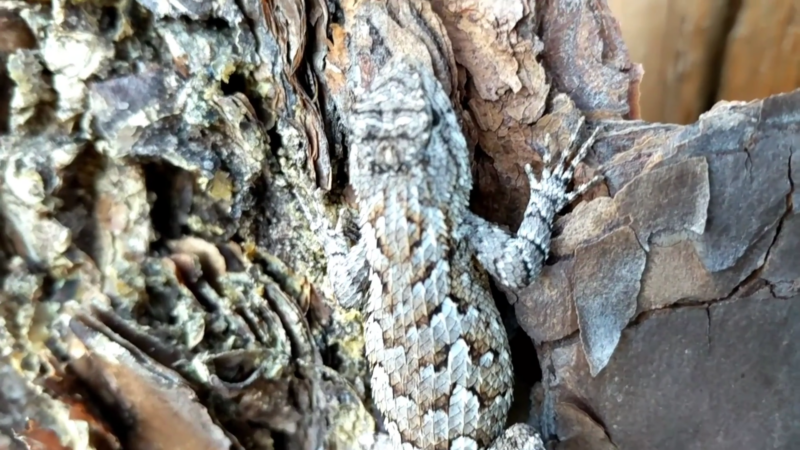Florida is home to a diverse range of lizard species, many of which are fascinating to both locals and visitors alike.
The five most common lizards found in Florida include the Brown Anole, Green Anole, Eastern Fence Lizard, Florida Scrub Lizard, and Island Glass Lizard.
These lizards thrive in various habitats, from sandy scrub regions to urban areas and coastal dunes.
Table of Contents
Toggle1. Green Anole
The Green Anole (Anolis carolinensis) showcases a bright, lime green body with a white throat and underbelly. Under stress or in colder temperatures, it can change to a darker brown while keeping its white throat marking.
These lizards typically measure 5 to 8 inches in length. Males are generally larger than females and have a pink throat fan, or dewlap, used for display. Their slim bodies and long tails aid in agility and quick movement through their arboreal habitats.
| Feature | Description |
|---|---|
| Color | Lime green or brown |
| Length | 5 to 8 inches |
| Unique Trait | Pink dewlap (males) |
Behavior and Diet
Green Anoles are primarily arboreal, favoring trees, shrubs, and other vertical structures. They are diurnal, being most active during the day. These lizards are territorial and males often engage in displays of dominance, including extending their dewlap and performing push-ups.
Their diet consists mainly of small insects and arachnids. Green Anoles are efficient hunters, often seen darting after prey.
They are commonly found in suburban areas, including gardens and parks. They are harmless to humans and can be beneficial by keeping insect populations in check.
These lizards can sometimes be found inside homes, particularly near windows and doors.
In areas where Green Anoles are common, they often become part of the local wildlife scenery.
2. Brown Anole
The Brown Anole (Anolis sagrei) usually exhibits a light brown or grayish color, often with darker patterns on its body. Males typically have bright orange or red throat fans called dewlaps. They can reach up to 8 inches in length, including the tail.
Brown Anoles are easily recognized by their high tail crest, which is more pronounced in males. Unlike the Green Anole, Brown Anoles never change their color to green, remaining in various shades of brown throughout their lives.
Brown Anoles are prolific breeders, with breeding season occurring from March to October. Females lay single eggs every one to two weeks during this period, often hiding them in moist soil or leaf litter.
Females can store sperm, enabling them to fertilize eggs multiple times from a single mating. The eggs usually hatch within 4-6 weeks. This high reproductive rate contributes significantly to their invasive presence in Florida.
The presence of Brown Anoles in Florida has led to a decline in native lizard species, particularly the Green Anole. They are aggressive competitors for food and habitat, often displacing native species from their preferred environments.
3. Florida Scrub Lizard
This species is native to the sandy, well-drained scrublands of Florida and faces significant challenges due to habitat loss.
| Characteristic | Details |
|---|---|
| Scientific Name | Sceloporus woodi |
| Common Name | Florida Scrub Lizard |
| Size | ~5 inches (including tail) |
| Color | Gray or gray-brown with brown stripes |
| Distinctive Features | Spiny scales, turquoise patches in males |
| Habitat | Sandy, well-drained scrublands |
| Geographic Distribution | Florida peninsula |
| Threats | Habitat loss due to development and agriculture |
| Conservation Status | Petitioned for listing under Endangered Species Act |
| Behavior | Camouflage, quick escape into burrows |
- Size: Typically around 5 inches in total length, including the tail.
- Coloration: Gray or gray-brown with longitudinal brown stripes on each side of the body.
- Sexual Dimorphism: Males have turquoise patches on the throat and belly, while females may have lighter patches on the abdomen but usually lack throat patches.
Habitat
- Preferred Habitat: Sandy, well-drained scrublands with open canopies of scrub oaks and sparse vegetation.
- Geographic Distribution: Found in three disjunct regions of the Florida peninsula.
Survival Strategies
- Camouflage: Its coloration provides excellent camouflage against sandy soil and dry leaf litter.
- Escape Tactics: When threatened, the lizard can quickly dart into burrows or under vegetation.
- Protection: Spiny scales may offer some protection against predators.
Due to significant habitat loss from development and agriculture, the Florida Scrub Lizard faces considerable threats.
It is being petitioned for listing under the Endangered Species Act due to these challenges.
4. Eastern Fence Lizard
The Eastern Fence Lizard, also known by its scientific name Sceloporus undulatus, is a fascinating small to medium-sized reptile.
Measuring between 4 to 7.5 inches in length, these lizards are known for their distinctive back pattern featuring a row of W-shaped dark lines, each bordered by a lighter edge.
Their color can range from tan to gray, and even nearly black.
Male lizards are especially notable during the mating season when they display bright blue patches on their bellies and throats, making them easier to distinguish from females.
- Size: 4-7.5 inches
- Coloration: Tan, gray, or nearly black
- Distinctive Markings: W-shaped dark lines with lighter edges on the back
- Male Identification: Bright blue patches on the belly and throat during mating season
Adaptations for Survival
- Protective Scales: Their rough, keeled scales provide protection against predators and harsh environmental conditions.
- Camouflage: Their coloration helps them blend into their surroundings, such as tree bark and rocky surfaces, which aids in evading predators.
- Climbing Ability: They are excellent climbers, often seen on tree trunks, fences, and walls. Their sharp claws give them a strong grip, allowing for quick escapes by climbing.
Predators and Threats
Eastern Fence Lizards face a range of predators and threats. Predatory birds like hawks and kestrels, as well as snakes such as the eastern racer and rat snake, are common dangers.
Additionally, habitat destruction and fragmentation due to human activities pose significant risks to their population.
Despite these challenges, the Eastern Fence Lizard demonstrates remarkable resilience, adapting and surviving in various environments.
| Predator Type | Examples |
|---|---|
| Birds | Hawks, Kestrels |
| Snakes | Eastern Racer, Rat Snake |
| Larger Mammals | Various species |
| Human Activities | Habitat destruction, fragmentation |
Habitat Preferences
- Environments: Forests, grasslands, suburban areas
- Climbing Spots: Tree trunks, fences, walls
- Activity Pattern: Diurnal (active during the day)
5. Knight Anole
It is commonly seen in Florida, where the warm climate and abundant food sources provide an ideal habitat for this species.
| Characteristic | Details |
|---|---|
| Scientific Name | Anolis equestris |
| Common Names | Knight Anole, Cuban Giant Anole |
| Size | 13 to 20 inches (33 to 51 cm) |
| Color | Vibrant green with yellow/white stripe |
| Diet | Insects, invertebrates, small vertebrates, fruits |
| Habitat | Arboreal, primarily in trees |
| Geographic Distribution | Florida, originally from Cuba |
| Unique Features | Large size, prominent dewlaps in males |
| Behavior | Opportunistic feeder, excellent climber |
Largest of the anole species, with a size that sets it apart:
- Length: 13 to 20 inches (33 to 51 cm)
- Coloration: Vibrant green with a distinctive yellow or white stripe running along the side
- Sexual Dimorphism: Males have larger heads and more prominent dewlaps (throat fans) than females, which are used during mating displays and territorial disputes.
Dietary Patterns
- Primary Diet: Insects and other invertebrates
- Secondary Diet: Small vertebrates such as frogs and smaller lizards
- Occasional Diet: Fruits and plant matter
Climbing Skills
- Physical Adaptations: Strong limbs and specialized toe pads that provide excellent grip and agility
- Behavior: They spend most of their time in trees, using their climbing skills for hunting and evading predators. Their agility allows them to ambush prey from above and escape threats by swiftly moving through the branches.
Related Posts:
- Preparing for Baby’s Arrival - What You Need vs.…
- Buc-ee’s Hours and Menu Prices for 2024 - Everything…
- Common Problems with the Toyota RAV4 and How to Fix Them
- Top 10 Resorts in Southeast Asia Where You Can Get…
- 18 Types of Ladybugs Which You Should Know About
- Dog Harness vs Collar - What Vets and Trainers Want…



